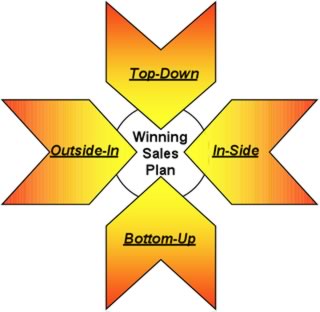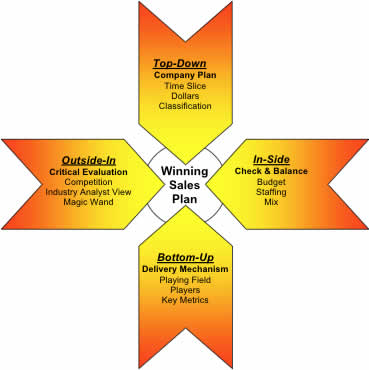
www.kickstartall.com
Build A Successful Sales Plan
By Janet Gregory
At the start of each new fiscal year your sales plan should be polished and ready for action. Approach your sales plan from four perspectives and the resulting action plan will be clear, even when you are wildly busy closing out the sales and fighting fires. You can construct a realistic sales plan that maps out how the company goals can be achieved. Constructing a good plan follows these four key approaches.

1) Top-down: Start with the end in mind.
 This is the company plan and is often referred to as the top-down approach. Top-down planning is the company’s expectation for sales. Top-down planning got an undeserved bad reputation as sales interpreted it as “unrealistic management expectations.” That may be the case in some situations but more often it is due to inadequate sales planning in the three other key elements. Three building blocks of top down expectations guide construction for the whole sales plan.
This is the company plan and is often referred to as the top-down approach. Top-down planning is the company’s expectation for sales. Top-down planning got an undeserved bad reputation as sales interpreted it as “unrealistic management expectations.” That may be the case in some situations but more often it is due to inadequate sales planning in the three other key elements. Three building blocks of top down expectations guide construction for the whole sales plan.
Time slices define the significance of calendar metrics. The time slice will typically have two main benchmarks: annual (coinciding with the company fiscal year) and either quarterly or monthly (based on business cycle). These blatantly obvious building blocks establish the time slices that frame every other element of the plan from compensation plans to sales activity expectations.
Dollars are the unit of measurement for the plan. “The number” as it is lovingly referred to by sales.
Classification provides the precise meaning for the unit of measure. Are the dollars booking dollars, revenue dollars or some form of gross margin dollars? Careful definition of what constitutes quota retirement is essential to a successful sales plan.
Characteristics of the two most common top-down classifications:
- Booking Definition
- Terms & Conditions mutually agreed to
- Payment terms
- Valid configuration & pricing
- No contingencies or side letters (i.e. trials or acceptance criteria)
- Net booking amount (after discounts, fees, taxes, etc.)
- Delivery expected within guidelines
- Revenue Definition
- Same items listed above
- Net revenue amount (after discounts, fees, taxes, etc.)
- Products shipped or services invoiced
- Consistent with standard accounting practices
2) Bottom-up: Build off your strengths.
 This is performance based planning and is often referred to as the bottom-up approach. Bottom-up planning looks in the rear view mirror of past performance for trends and markers that help predict future success. Bottom-up planning got an undeserved bad reputation as management interpreted it as “sales sandbagging opportunities.” In most companies neither sales nor management pay enough attention to the trends and indicators of past sales performance. Bottom-up planning provides the delivery mechanism for the top down plan. Three essential building blocks form the backbone for a successful sales plan.
This is performance based planning and is often referred to as the bottom-up approach. Bottom-up planning looks in the rear view mirror of past performance for trends and markers that help predict future success. Bottom-up planning got an undeserved bad reputation as management interpreted it as “sales sandbagging opportunities.” In most companies neither sales nor management pay enough attention to the trends and indicators of past sales performance. Bottom-up planning provides the delivery mechanism for the top down plan. Three essential building blocks form the backbone for a successful sales plan.
Playing field looks into “who’s buying.” These are your references, case studies and the bowling alley (as Geoffrey Moore calls it). The playing field may be very specific (a niche) or very broad but it is not unlimited and undifferentiated. Take a careful look at who is buying. Geographically. Industry Vertical Markets. Departmental “Horizontal” Markets. Business demographics or “firmographics” (SOHO, SMB, Enterprise). New accounts and existing customers. What are the trends? Where is the growth? Which markets are declining?
Players cover the playing field and answer the question: “Who’s selling?” It can be an individual sport with only a single sales channel but more commonly today it’s a team sport with multiple players. The players vary widely for each industry but tend to fall into one of these groupings:
- Direct: E-commerce, inside sales, field sales
- Single tier: Agent, VAR, reseller, integrator
- Multi-tier: OEM, distributor, catalog, wholesaler
Be bold. Ask tough questions. Are the high growth and most profitable markets well covered? Are you committed to making your players successful? Are they committed to you? How do you handle channel conflict?
Key Metrics will be unique to each business; however two are universally critical: ASP (average selling price) and sales cycle time (time to closure). These two metrics allow for depth in the planning process. Projections of close rate, proposal activity, lead generation, staffing requirements and new hire ramp up can all be assessed.
3) In-side: Make it a holistic effort.
 The in-side (or side-in) approach is traditional accounting-based business planning. It provides the check and balance between top-down company expectations and the bottom-up sales requirements for delivery.
The in-side (or side-in) approach is traditional accounting-based business planning. It provides the check and balance between top-down company expectations and the bottom-up sales requirements for delivery.
The budget is the most prominent in-side ingredient and many companies confuse it with the top-down plan. But, it is the third step in building the sales plan for a reason. The budget is not the plan. The purpose of the budget is to be the acid test for the plan. It is the in-side answer to the question “Can we afford our business plan?”
Staffing is the single largest expense item in a company budget. There are tremendous dynamics in staffing. Departmental staffing will vary based on where the corporation is in its lifecycle. Early stage companies will invest heavily in development and less in sales. Companies in their prime will invest heavily in sales & marketing. Staffing investment for specialized selling skills will change based on the go-to-market strategy (combining “players” and the “playing field”). Sales staffing is the in-side answer to “Can we get the job done?”
Mix of products and services is what is being sold. Mix is an important cross check to make sure that the right “players” are being employed to bring the products and services to market. Mix provides the check and balance for profitability goals. Industries where buyers expect discounts based on volume, competition, contract term or other factors should also build pricing and discount strategies to complement mix.
4) Outside-in: Check the weather before going out to play.
 The final step in the process is to take an outside-in approach to the sales plan. Stand on the outside, with a marketplace perspective, and take a critical look at your sales plan. How will competitors react to your plan? How will industry analysts view your plan?
The final step in the process is to take an outside-in approach to the sales plan. Stand on the outside, with a marketplace perspective, and take a critical look at your sales plan. How will competitors react to your plan? How will industry analysts view your plan?
Competition will build a competitive counter strategy. Will your sales plan stand up to their market reaction? What new surprise products or “players” will they bring into the market next year? Anticipate competitive moves and build that into the plan.
Industry Analysts are paid for their opinions. How will they view the results of this sales plan? What advice or recommendations would they make? How would they rank your company at the end of the year against other companies in your market space? Draft the press release and the industry brief that will be published at the end of the plan year.
The magic wand of “what if…” there were no resource, budget or marketplace constraints is the best test of a plan. Do some out-of-box thinking on what it would take to do 2X of the company plan. New ideas will emerge that can become part of your success plan.
A sales plan built for success is based on the intersection of four key approaches.

Janet Gregory leads the sales readiness practice for KickStart Alliance. For assistance with sales strategy, sales planning, training, compensation or any aspect of sales operations, contact Janet. For help in aligning sales & marketing for results, contact any member of the KickStart Alliance team.